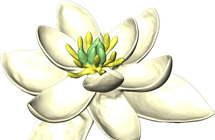花朵的祖先像白莲花和白百合结合体
|
All living flowers ultimately derive from a single ancestor that lived about 140 million years ago, a study suggests. Scientists combined models of flower evolution with the largest data set of features from living flowers ever assembled. From this the team was able to infer the appearance of the ancestral flower.
The flower had many concentric cycles of petal-like organs in sets of three, arranged in whorls, and was bisexual. Hervé Sauquet, from Université Paris-Sud, France, one of the authors of the paper published last week in Nature Communications said: "There is no living flower that looks exactly like the ancestral one. This is a flower that existed at least 140 million years ago and has had considerable time to evolve into the incredible diversity of flowers that exist today." Dr Jason Hilton from the University of Birmingham, UK, who was not involved in the study, said: "The structure and organization of the ancestral flower has remained enigmatic. For instance, we don't know if the oldest flowers were unisexual or bisexual, or if they were pollinated by wind or insects." To reconstruct the appearance of the first flower, the scientists recorded the features - such as the petals and sepals - of the flowers from 792 living species. They mapped the distribution of these features on to the evolutionary tree of flowering plants enabling them to build a picture of what flowers looked like at key points in their history - including the last common ancestor of all living flowers. The first flower is reconstructed with petal-like structures arranged in a whorl, so each petal appears in the same plane, like a common lily (but with more whorls), rather than in a spiral, where petals overlap in a spiral arrangement around the stem, like a lotus. "For some of the features we studied, the result was surprising, especially the fact that organs (such as sepals and petals and the stamens) were probably arranged in whorls instead of spirals, as commonly assumed for the ancestral flower," said Hervé Sauquet. Sex evolution in flowers has been highly debated. Flowers can be unisexual or bisexual and this study infers a bisexual early flower with both male and female organs. "This study is important as it tells us how complicated the ancestral flower is likely to be - now the search is on to find it or something closely resembling it in the fossil record. That's if the model is correct - only time (and further study) will tell," said Jason Hilton. |









